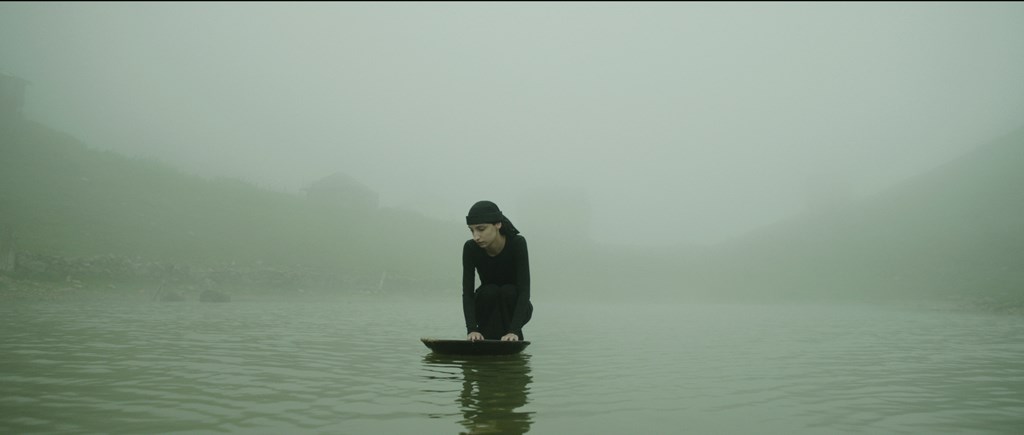
Where the Magic Fish Can’t Dream
In Werner Herzog’s film Where the Green Ants Dream, aborigines living in a small settlement in Australia oppose the construction of a bore-hole, believing that the rare species of green ants living there would lose their sleep and eventually become extinct.
In Zaza Khalvashi’s new film, “Namme”, a magical fish loses its medicinal properties after the construction of a nearby dam releases polluting substances into the river. The construction process is shown only briefly and almost inconspicuously at the beginning of the film to give context, but in the final shot of the film, it grabs the viewer’s attention with its deafening roar. Indeed, the ending of the film is all the more intimidating given the calm, slightly mysterious and – as the director puts it –“quiet” tone of the film up to that point.
Zaza Khalvashi’s “quiet film” can be seen as part of the “slow cinema” trend in modern art house film. However, the unhurried, slightly sluggish rhythm of Khalvashi’s lengthy frames is aimed more at creating what Gilles Deleuze calls “image-time”. This gentle pace of this film is aimed at bringing the viewer into proximity with the story and its characters rather than simply conveying the monotony of every life and undivided time, as in so many films in the “slow cinema” trend.
The everyday rhythm of life in a poor part of the Upper Adjara region is woven so tightly into the plot of the film that the viewer sees nothing strange in the ability of a hermit-like father-daughter pair to cure people using water from a creek housing this magical immortal fish.
This life-giving fish can be interpreted as a biblical illusion, but Khalvashi has also mentioned a local legend, well-known in Adjara, about a girl who cures people with the help of a fish. According to this tale, the girl releases the fish after falling in love. In “Namme” also, the fish is released, almost merging with the whiteness of the snow and the scattered layers of mist that cover the landscape in this film. In “Namme” though, the girl releases the fish after falling in love, setting it free because both the fish and the water have lost their magical properties.
In this context, one can recall a better-known mythological woman, Medea, who also loses her magical powers after falling in love, and who also leaves her homeland. Medea’s intimate connection with nature and the elements is lost after the balance of her life is disturbed.
Mythological motifs in “Namme” are applied to an environmental disaster – natural harmony disturbed by the construction of a hydroelectric dam on the Adjaristskali River, breaking the connection between Namme and her father and the elements of water and fire.
[[{"fid":"3518","view_mode":"default","fields":{"format":"default","field_file_image_alt_text[und][0][value]":false,"field_file_image_title_text[und][0][value]":false,"field_description[und][0][value]":"","field_description[und][0][format]":"filtered_html"},"type":"media","field_deltas":{"1":{"format":"default","field_file_image_alt_text[und][0][value]":false,"field_file_image_title_text[und][0][value]":false,"field_description[und][0][value]":"","field_description[und][0][format]":"filtered_html"}},"attributes":{"class":"media-element file-default","data-delta":"1"}}]]
Khavlashi’s film is predicated on the juxtaposition between these two parallel themes – fairy tale, mystical and mythological motifs on the one hand, and the unembellished reality of everyday life in Upper Adjara on the other (although photographer Giorgi Shvelidze’s imagery of the region is expressiveand mesmerizing). Neither of these two themes dominates the other, but rather balances each other out. The director manages to get his message across without stepping into the territory of harsh and direct documentary journalism or, alternatively, simply entertaining viewers with abstract mythology and mesmerizing shots of nature (something that is hard to achieve given the breathtaking beauty of the natural environment in Upper Adjara).
Only the father, with his supernatural curative powers, and his daughter, called ‘Namme’, remain at their village home. Unlike young Namme, none of the three older brothers have followed in their father’s footsteps, but in their own way, all three of them are physicians of souls. Symbolically, one of them is a Christian priest, the other a mullah and the third an atheist teacher. However, any expectations for conflict and confrontation are thwarted. The director does not bring these characters into conflict with the phantom of their father, and he has no agenda of exposing religious or ideological conflicts or discrimination – despite this being a hot-topic in modern Georgia. Rather, as noted above, Khalvashi keeps the tone of this film “quiet” – softening sharp edges and muting loud notes. In this film, the director is more interested in showing unity in difference.
In cinematographic terms, this unity is shown most masterfully in the scene where the father and daughter spoon-feed each other honey. (It’s perhaps a separate area of discussion, but the moderated and pathos-free performance of these non-professional actors should be pointed out. For some reason, it seems that in most cases non-professional actors in Georgian cinema deliver much more convincing performances than professionals, who seem to have a hard time parting with established mannerisms and unnatural intonation). This scene is short with northern renaissance-style lighting – its warm, honey-coloured tone is very soft, tasteful and simple. Khalvashi reminds us here what cinematic language is about and how it differs from literature and painting.
In the first instance, Namme is a film that needs to be perceived visually. Photographer Shvelidze builds the imagery on gradations of half-tones, and like the director’s construction of the whole film, Shvelidze’s imagery has its own sense and emotion. Balance is preserved here as well – the most hypnotizing imagery is not there just for its own sake – it constantly serves the process of storytelling and pushes the development of the narrative forwards.
Zaza Khalvashi’s so-called “quiet film” ends with a disturbingly loud bang. This is not only a warning about an environmental catastrophe that has both local and global dimensions. This cinematic noise starts building within the viewer themselves and stays with them for some time after watching the film.
Namme was premiered at the Tokyo International Film Festival.
ეს სტატია მხოლოდ გამომწერებისთვისაა. შეიძინე შენთვის სასურველი პაკეტი



